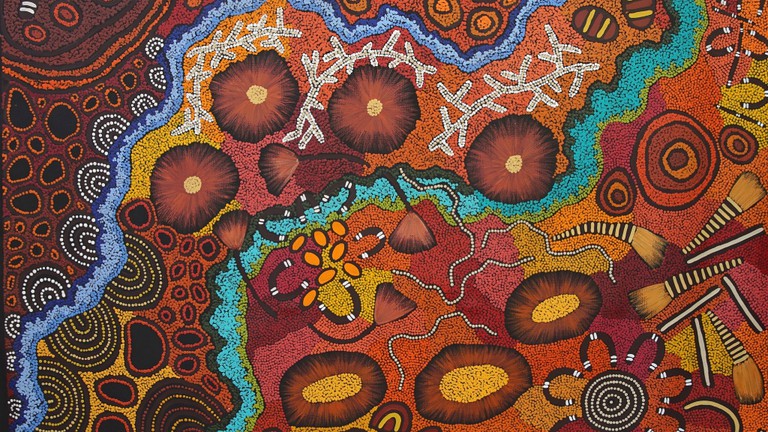The indigenous people of Australia have been known to have originated some 60,000 years ago. Art serves to form just not a visual medium but at the higher level tends to create spiritual experiences as well. It is important to recognize some patterns to the aboriginal art that makes it possible to relate to and understand the art form.
Table of Contents
1. Lack of a written language
The native people of Australia do not have a written language. For centuries the art form that they produce has been a medium of communication between the tribes and folks of the aboriginals. Colors and patterns tend to take on meanings which are not evident to the outside world and this was of particular use at times of high pressure on the native peoples. Thus, the white invaders to the native lands could not understand what was being conveyed to the people through art.
2. Different levels to the paintings
It has been observed that aboriginal art tends to apply at two or three levels most of the time. At the first level, art applies to the children and the younger generation among the aboriginals. At the next level, art is made evident to the elders and community leaders and at the highest level, the art takes on spiritual and cultural meanings.
3. There is no single aboriginal culture
What has been observed among the aboriginals is that there is no single unified code or control over the indigenous people. At best they can be called as groups of tribes and it is not correct to view all artists as being the same. Although there could be said to be a common thread that ties all the different countries together, the aboriginals are a fiercely combatant group of people.
4. The languages run into the hundreds
When the first British settlers came to the land, there were over 250 kinds of dialects and languages. After a brutal attempt to modernize the indigenous people, there are currently over 100 active languages in use. With each language group, the art form is different too. Thus, it would be wrong to classify aboriginal art into a single entity. This is also the prime reason that aboriginal art happens to have a variety that often puzzles people as the area is rather small compared to the variety on offer.
5. The aboriginal culture is vibrant today
Despite the huge persecution that the indigenous culture faced for close to two hundred years, it has been possible to preserve some major areas of the art form from the distant past. Currently, it is possible to come across a movement to preserve what is left of the culture for future generations and beyond. Frequent get together and jamborees tend to be a convenient meeting place for the indigenous people and their art form.
6. Aboriginal culture is not restricted to the outback alone
It would be rather wrong to say that aboriginal culture is restricted to the outback alone but that current day innovations like the television and radio have enabled the spread of the culture beyond the outback and into the local population of the cities and towns too. This feature is more evident in the smaller towns and villages that have seen the adoption and adaptation of aboriginal art to some of the building structures and painting. It has been brought about with the better integration of the local people to activities that are more mainstream in nature.
7. The role of music
Safe it is to say that music or specifically aboriginal music is inseparable from the aboriginal culture and art. Present generations of musicians have managed to master the indigenous musical instruments and it is not strange to catch glimpses of music being performed that are truly local in nature. The music is another means of storing history and tales of a bygone era. Community singing was a regular feature of the aboriginal art and the whole communities participated in them.
8. Sport as a means of recreation
It has been learned that sports formed a major part of the people indigenous to Australia. Cave painting has been known to depict sports events and it can be inferred that periodic competitions like those of today’s Olympics were present at those times a few thousands of years ago. Of late some of the aboriginal talent has been seen being put to practice in the modern era of sports. Few people would doubt the ability of the aboriginal sportsmen and women in their fields of play if a small glimpse is hard to the rock painting and such aboriginal art and what they convey to the outside world of the days gone by.
Conclusion
The ordinary person would perhaps say that aboriginal art is at best colorful in nature. But a brief perusal of the subject would make it evident of the depths to which the art form has managed to penetrate to provide not just a means of artistic expression but the preservation of whole lifestyles as well.













